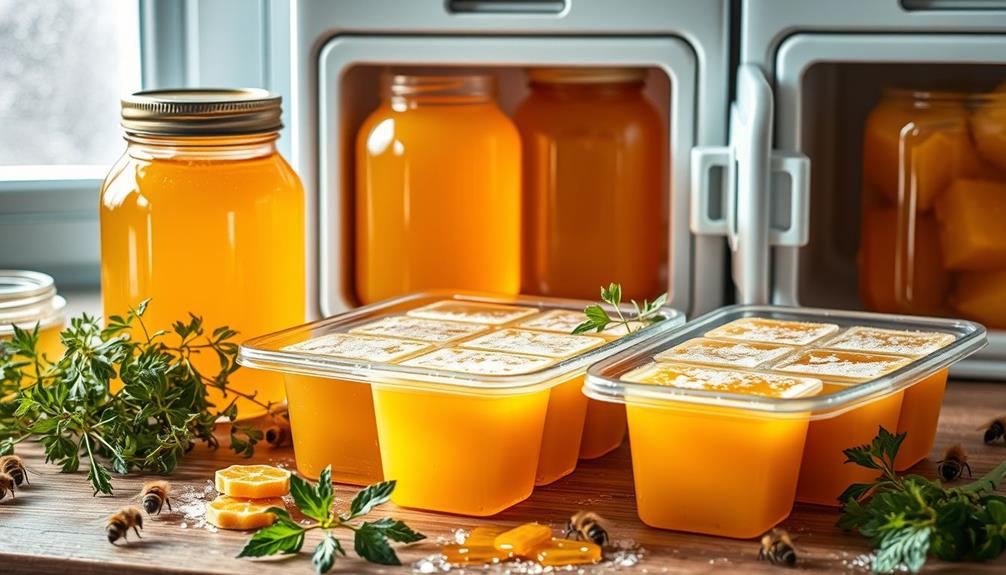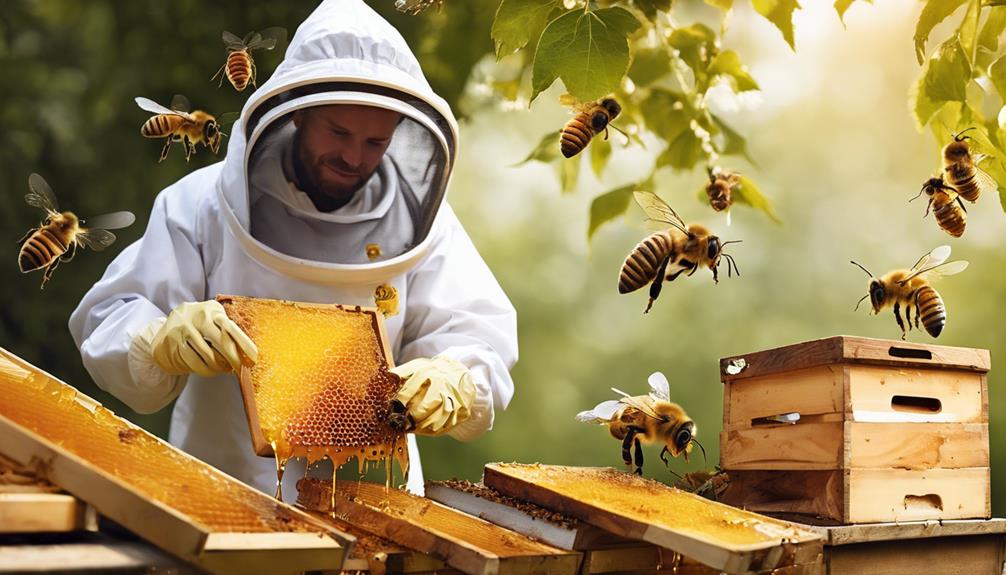Crystallized honey is perfectly normal and actually indicates less processing, preserving its rich flavor and health benefits. To liquefy it, you can use a water bath; simply warm water in a pot, immerse the jar, and stir gently. Oven heating at a low temperature also works well, but monitor carefully to maintain its properties. Other methods include gentle stirring to warm it up or using a microwave in short bursts. Remember, crystallization doesn't spoil the honey; it enhances its texture and character. Want to know more about the benefits and storage tips for your honey?
Key Takeaways
- Crystallized honey can be re-liquefied using methods like a warm water bath or gentle oven heating to preserve its nutrients.
- Stirring crystallized honey can aid in liquefaction by generating slight warmth, improving texture without additional heat.
- Crystallization is a natural process, indicating purity and quality, and does not affect the honey's flavor or nutritional value.
- Crystallized honey retains rich flavors and beneficial properties, making it a desirable choice for various culinary uses.
- Proper storage at optimal temperatures and in airtight containers can prevent unwanted crystallization while maintaining honey's quality.
Understanding Honey Crystallization
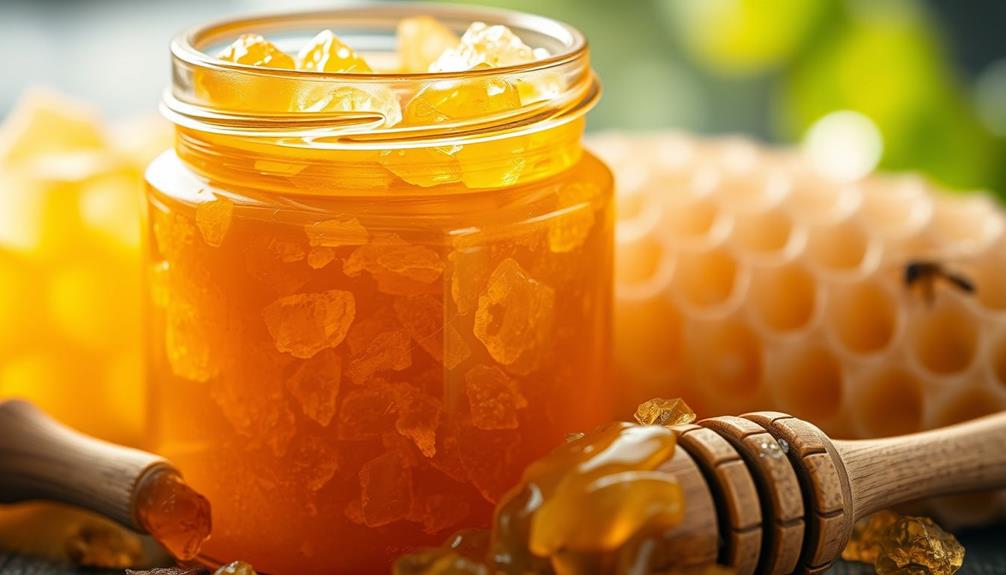
When you open a jar of honey, you might notice it's crystallized, which is perfectly normal. Honey is made up of 80-85% sugars, primarily fructose and glucose, and 15-20% water. The crystallization process mainly occurs due to glucose forming a network of sugar crystals.
If you have honey with high glucose content, like rapeseed or dandelion honey, you'll find it can crystallize more quickly than other types. In contrast, honeys higher in fructose, such as forest honey, usually stay liquid for a longer time. This phenomenon is similar to how certain food items can undergo changes due to their composition, such as cold medications overview, where understanding the ingredients is essential.
Another factor to take into account is the presence of crystallization nuclei, such as pollen or air bubbles, which can kickstart the crystallization process. Different honey varieties crystallize at varying rates; acacia honey may take up to three years to crystallize, while some flower honeys can turn solid within weeks.
It's important to remember that crystallized honey doesn't mean it's of poor quality. In fact, it often retains the same flavor and nutritional value as fresh honey, making it perfectly safe for you to consume. Understanding this process helps you appreciate the natural beauty of crystallized honey.
Factors Affecting Crystal Formation
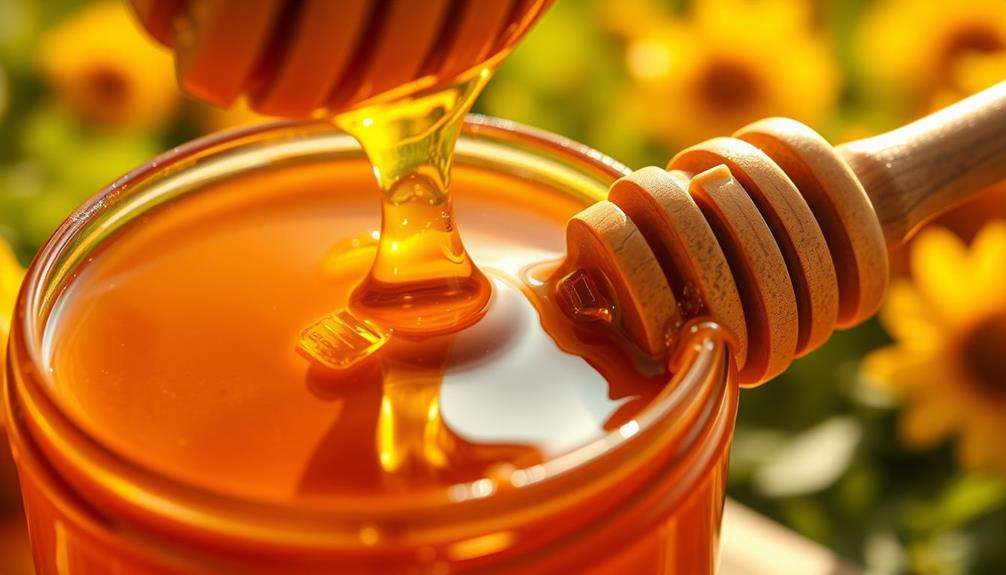
Several key factors influence the crystallization of honey, directly impacting how and when it forms crystals.
First, the sugar composition plays an essential role; honey with higher glucose levels crystallizes faster. If you have flower honeys like rapeseed or dandelion, expect quicker crystallization.
Understanding the importance of credit score can also help in making informed financial decisions when purchasing high-quality honey products.
Next, consider the water content. Honey with around 17% water tends to crystallize more rapidly due to the higher sugar concentration.
Additionally, the presence of crystallization nuclei, such as pollen or air bubbles, can kickstart the crystal formation process.
Storage conditions matter too. Keeping your honey in cooler temperatures greatly speeds up crystallization.
The Quality of Crystallized Honey

When you see crystallized honey, don't mistake it for low quality. In fact, this natural process often indicates that the honey hasn't been overly processed and retains its rich flavor and aroma.
The unique texture of crystallized honey can enhance its taste, proving it's still a delightful choice. Additionally, similar to the benefits of butter, crystallized honey can bring its own set of advantages, such as providing a more concentrated sweetness.
Many appreciate how the unique texture of crystallized honey can enhance its taste, proving it's still a delightful choice.
Crystallization Indicates Quality
Crystallization signals quality in honey, showcasing its high glucose content, especially in varieties like rapeseed and lime. This natural process doesn't mean the honey is spoiled; instead, it indicates purity and often enhances certain flavor profiles.
When you encounter crystallized honey, you're likely enjoying a product that's less processed and retains its nutritional benefits.
Here are some key points about crystallized honey:
- High Glucose Content: Honeys rich in glucose, such as rapeseed and lime, crystallize faster than those with higher fructose content, like forest and acacia honey.
- Texture and Flavor: Many people appreciate the unique texture of crystallized honey, which can resemble fresh honeycomb. It often delivers a delightful flavor experience.
- Nutritional Value: Crystallized honey maintains its original flavor and nutritional properties, ensuring it remains as beneficial as liquid honey, regardless of its texture.
Flavor Retention in Crystallized
With its rich flavor and aroma intact, crystallized honey often delivers a taste experience reminiscent of fresh honeycomb.
You'll find that this unique texture doesn't compromise the delightful essence of honey; in fact, it can enhance certain flavor profiles as the sugars concentrate during crystallization. Many consumers appreciate that crystallized honey maintains the same beneficial nutrients and enzymes found in its liquid counterpart, ensuring it remains a healthy choice.
Interestingly, not all honeys crystallize at the same rate. Varieties with higher fructose content, like forest or acacia honey, tend to stay liquid longer. This shows that crystallization isn't a universal trait across all types of honey.
When you sample crystallized honey, you might enjoy its distinct mouthfeel, which contrasts with the smoothness of liquid honey while still providing the same delicious taste experience.
Methods to Re-Liquefy Honey
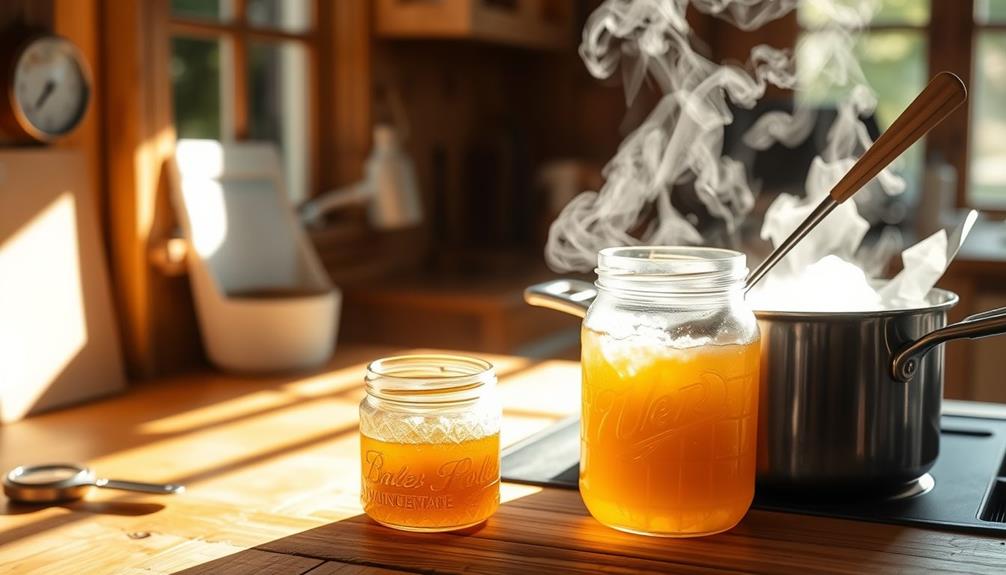
To re-liquefy your crystallized honey, you've got a few effective methods at your disposal.
The water bath method is ideal, as it keeps the temperature low enough to preserve nutrients.
Alternatively, you can use the oven heating technique, but remember to stir the honey afterward for the best results.
Water Bath Method
Restoring honey's smooth, pourable consistency can be achieved through the water bath method, a gentle and effective technique. This method helps you re-liquefy crystallized honey without exposing it to direct heat, ensuring you preserve its beneficial properties.
To use the water bath method, follow these simple steps:
- Prepare the Water: Fill a bowl or pot with warm water, ensuring the temperature doesn't exceed 40°C. This temperature keeps the honey's nutrients intact.
- Place the Honey: Submerge a jar of crystallized honey into the warm water. It's suitable for various containers, including glass jars, tubes, and squeeze bottles.
- Stir Continuously: As the honey warms, stir it gently. This helps dissolve the crystals more quickly and promotes even liquefaction.
Oven Heating Technique
The oven heating technique offers another effective way to re-liquefy crystallized honey while preserving its beneficial properties.
To start, preheat your oven to 40°C, which is the ideal temperature for maintaining honey's enzymes and nutrients. Be certain to use glass or metal containers for the honey, as plastic can melt or leach harmful substances.
Once your oven is ready, place the honey inside and heat it for about 15-20 minutes. It's essential to keep an eye on it during this time to prevent overheating, which could damage the honey's natural qualities.
After removing the honey from the oven, stir it well to achieve an even consistency and guarantee complete liquefaction.
This method isn't only quick but also effective, allowing you to restore your honey's spreadable texture without compromising its quality.
Just remember to monitor the process closely to avoid any mishaps. With this technique, you can enjoy your honey in its liquid form again, ready to sweeten your meals and beverages!
Stirring for Liquefaction
Stirring crystallized honey can be an effective and straightforward way to re-liquefy it, especially when it hasn't fully solidified. This method generates slight warmth, aiding in the liquefaction process and giving your honey a smoother, creamier texture.
To get the best results, follow these steps:
- Use a Clean Spoon: Start by using a clean spoon to stir your honey. This helps dissolve the crystals and improves the overall texture, making it more spreadable.
- Continuous Stirring: Keep stirring continuously while applying slight heat. This guarantees even heat distribution, preventing any local overheating that could damage beneficial enzymes.
- Combine with Warm Water: For even faster results, consider stirring in conjunction with a warm water bath. This can expedite the liquefaction process while preserving the honey's natural properties.
The Water Bath Technique

Using the water bath technique is an effective way to liquefy crystallized honey while preserving its natural nutrients and enzymes.
To start, place your jar of crystallized honey in a bowl or pot filled with warm water. Make certain the water temperature doesn't exceed 40°C; this will help retain the honey's beneficial properties. As the honey warms, stir continuously to dissolve the crystals more effectively. This stirring also helps achieve a smoother, creamier texture once the honey is fully liquefied.
This method is versatile, working well with glass jars, tubes, and squeeze bottles, making it perfect for home use. For the best results, allow the honey to sit in the water bath for 15-30 minutes. Be sure to check the consistency periodically and stir as needed to reach your desired texture.
The water bath technique is preferred over microwaving, as it greatly reduces the risk of overheating and nutrient loss. By using this gentle heating method, you can guarantee your honey retains its natural qualities while becoming perfectly fluid again.
Enjoy your beautifully liquefied honey in your favorite recipes or as a sweet treat!
Other Heating Methods
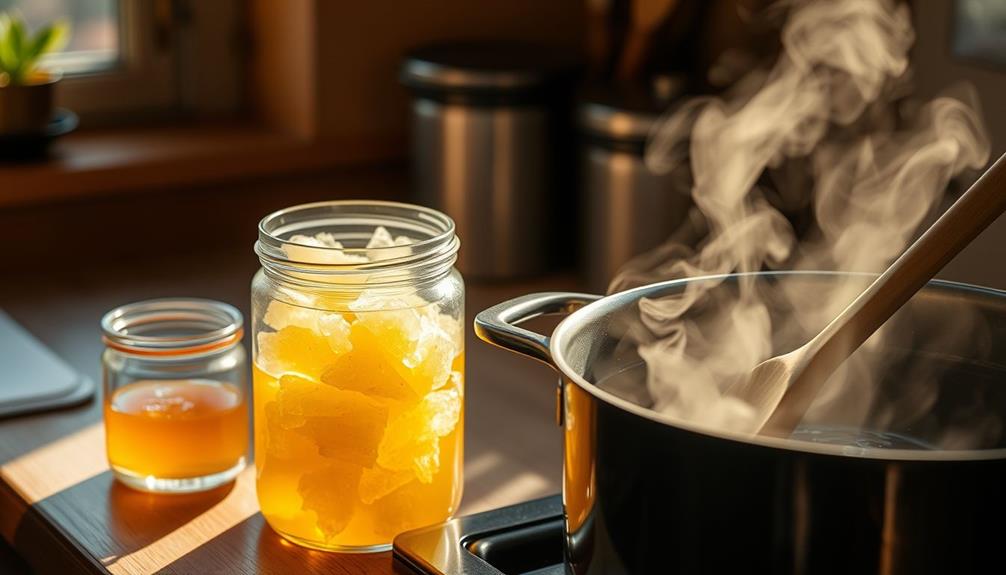
When it comes to liquefying crystallized honey, various heating methods can be effective in restoring its smooth, fluid texture. Each method has its own advantages, and you can choose based on what's convenient for you. Here are three popular options:
- Oven Method: Preheat your oven to 40°C and place the honey in glass or metal containers. Heat it for 15-20 minutes, then stir to guarantee an even consistency.
- Microwave Method: Use only glass jars and set your microwave to the lowest setting. Heat in short intervals, checking frequently to prevent overheating and nutrient loss.
- Gentle Stirring: If you want a no-heat approach, simply stir the crystallized honey. This generates slight warmth and helps dissolve the crystals, improving the texture without needing additional heat sources.
Additionally, consider using devices like a Melitherm or warm cabinet for more controlled heating. These methods help maintain honey's beneficial properties while effectively liquefying it.
Tips for Proper Honey Storage
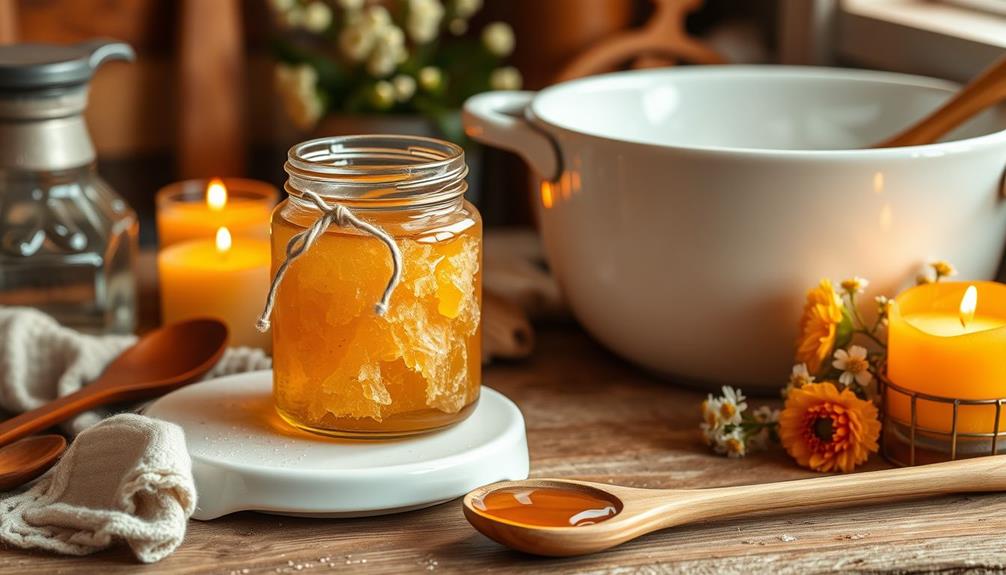
Proper honey storage is essential for preserving its quality and preventing crystallization. To keep your honey in its best condition, follow these tips:
| Storage Aspect | Recommended Practice | Why It Matters |
|---|---|---|
| Temperature | Store between 7-10°C | Maintains quality and prevents crystallization. |
| Container | Use airtight containers | Protects from moisture and contaminants. |
| Light Exposure | Keep away from direct sunlight | Extends shelf life and preserves flavor. |
Avoid refrigeration, as lower temperatures can speed up the crystallization process and make your honey less convenient to use. Instead, choose a cool, dry, and dark place for storage. Regularly check your honey for signs of crystallization and adjust conditions if necessary to keep it in liquid form.
Benefits of Consuming Crystallized Honey

Crystallized honey offers a unique taste experience that many people love. Its flavor and aroma can resemble fresh honeycomb, making it a delightful choice for your palate.
Don't worry about the crystallization; it's merely a natural process that enhances certain flavor profiles without indicating spoilage.
Here are some key benefits of consuming crystallized honey:
- Health Benefits: It retains all the health benefits of liquid honey, including antibacterial properties, antioxidants, and potential anti-inflammatory effects. You get the same nutritional value.
- Longer Shelf Life: Crystallized honey often lasts longer due to its lower moisture content, making it less prone to fermentation and spoilage. This means you can enjoy it for an extended period without worry.
- Versatile Use: Its unique texture makes crystallized honey a fantastic spread or an ingredient to add sweetness and character to your recipes. You can easily incorporate it into your morning toast or baked goods.
Incorporating crystallized honey into your diet not only delights your taste buds but also supports your health, making it a worthwhile choice.
Consumer Preferences and Awareness

Consumer preferences for honey have evolved considerably, with many people gravitating towards liquid honey for its convenience, while others appreciate the distinct texture of crystallized honey. You might find that the smooth consistency of liquid honey makes it easy to drizzle over your favorite foods or stir into beverages.
However, crystallized honey offers a unique mouthfeel that can enhance your culinary experiences. As awareness of honey quality and sourcing increases, you may notice a growing preference for organic and natural products among your peers.
Research shows that crystallized honey retains its flavor and nutritional properties, making it an excellent choice despite its texture. Understanding this can help you appreciate crystallized honey even more.
Transparency in honey production is essential for building your trust as a consumer. Knowing where your honey comes from and the testing results can lead to more informed purchasing decisions.
Surveys indicate that you're becoming more educated about what influences honey crystallization and how to re-liquefy it when needed. This knowledge not only enhances your overall experience but also supports your journey towards making healthier choices.
Frequently Asked Questions
How Can Crystallized Honey Be Made Liquid Again?
You can liquefy crystallized honey by placing the jar in warm water below 40°C, using a low-temperature oven, or microwaving in short bursts. Stir continuously to achieve a smooth, consistent texture while preserving nutrients.
Why Is the Purchased Honey Always Liquid?
Purchased honey's usually liquid due to industrial processing techniques. They filter out particles that cause crystallization, heat it to dissolve crystals, and blend varieties to create a stable, appealing product that lasts longer on shelves.
Which Honey Remains Liquid for a Long Time?
When you think of honey, picture a medieval banquet; forest and acacia honey stand out, staying liquid for months or even years due to their high fructose content and lower glucose levels. You'll love their smoothness!
Why Doesn't Honey From the Supermarket Crystallize?
Supermarket honey doesn't crystallize because it's finely filtered, often blended with sweeteners, and heated to eliminate natural enzymes. The controlled water content also helps maintain a liquid state, keeping it smooth and pourable.
Conclusion
So, next time you find your honey crystallized, remember it's not a sign of spoilage but a natural process. By gently re-liquefying it, you can enjoy its sweetness once more. Isn't it interesting how even in nature's changes, there's beauty and value? Just like in life, what seems like a setback can often lead to a richer experience. Embrace the crystallization, savor the journey, and appreciate every drop, whether liquid or solid.

